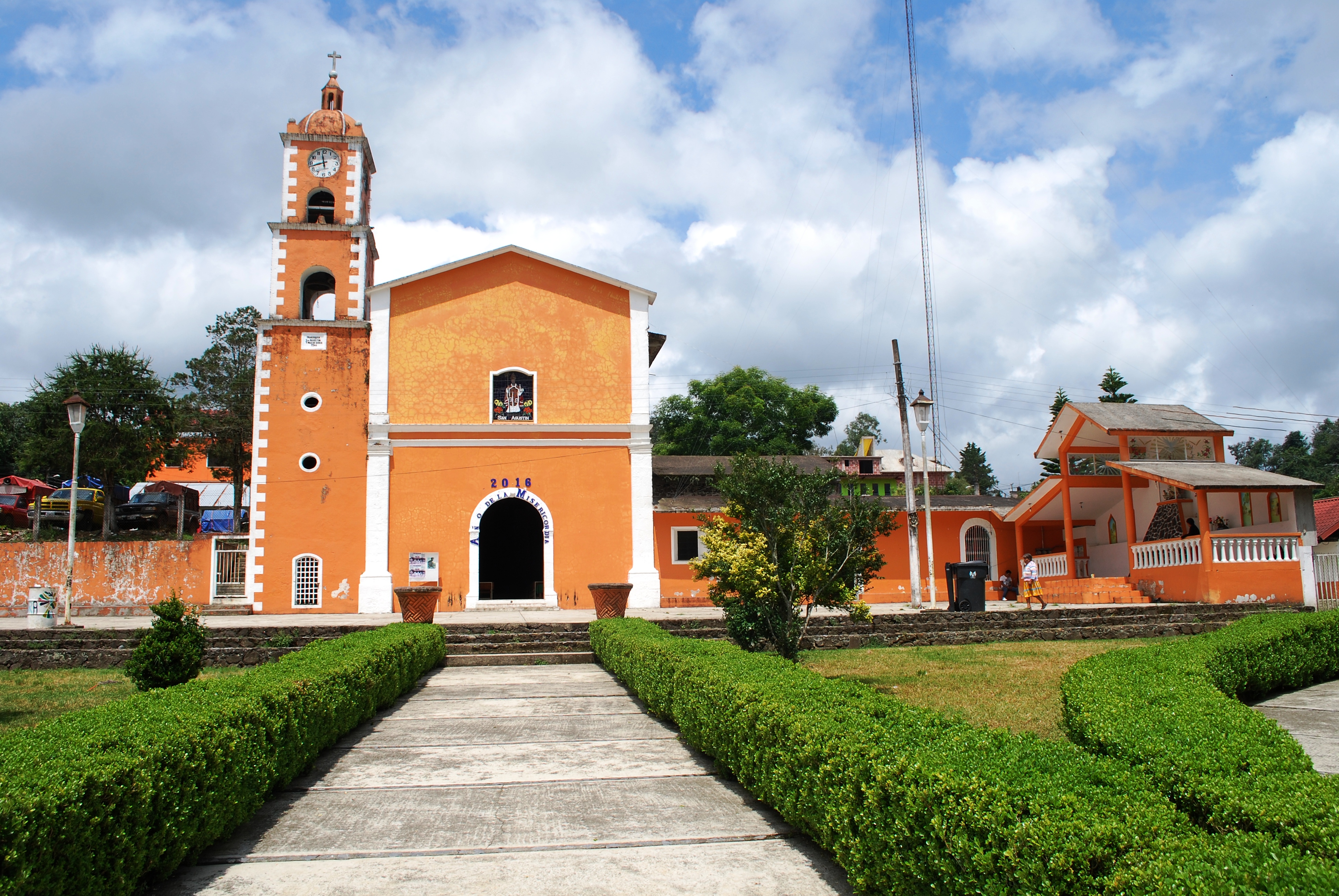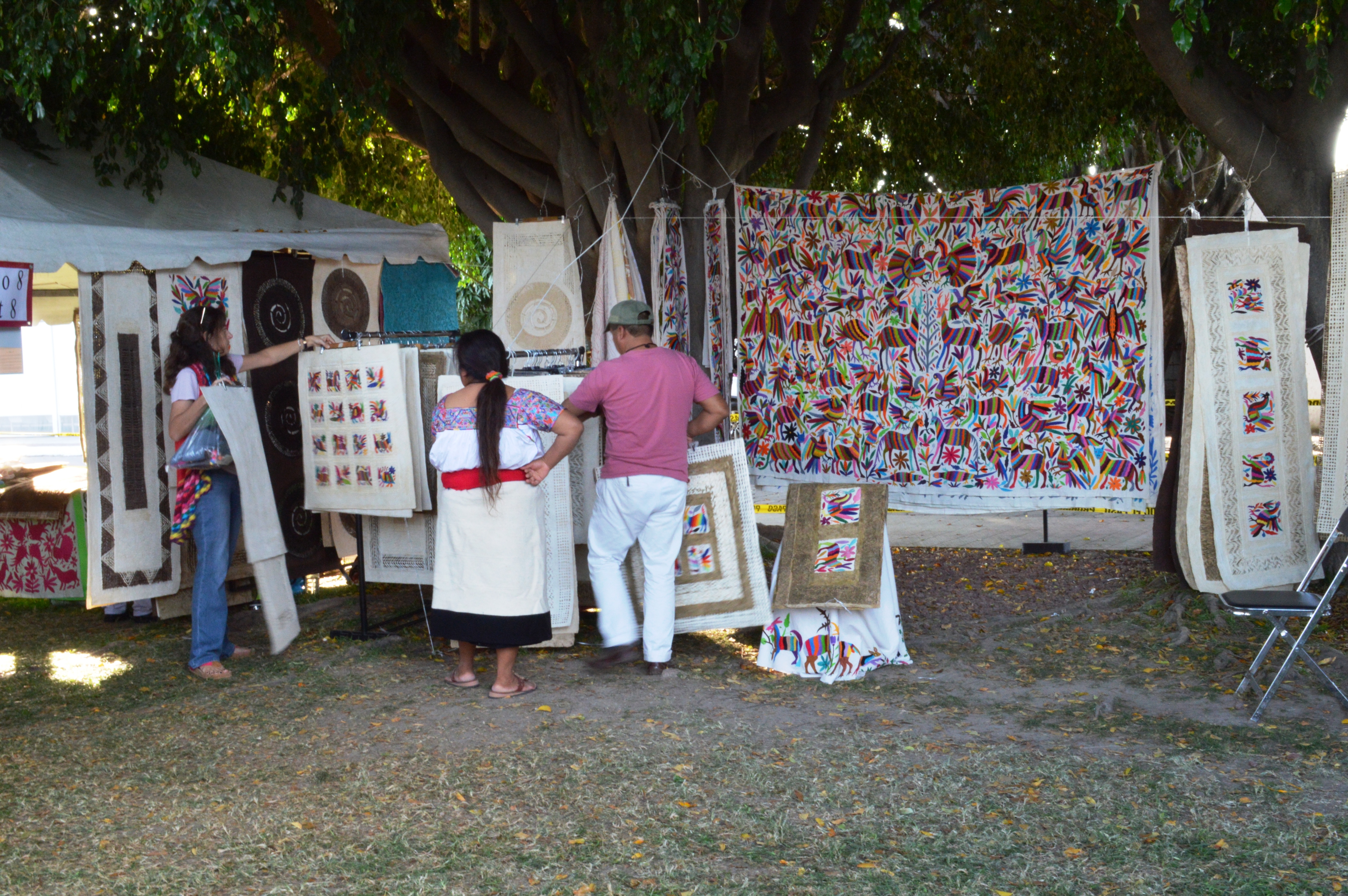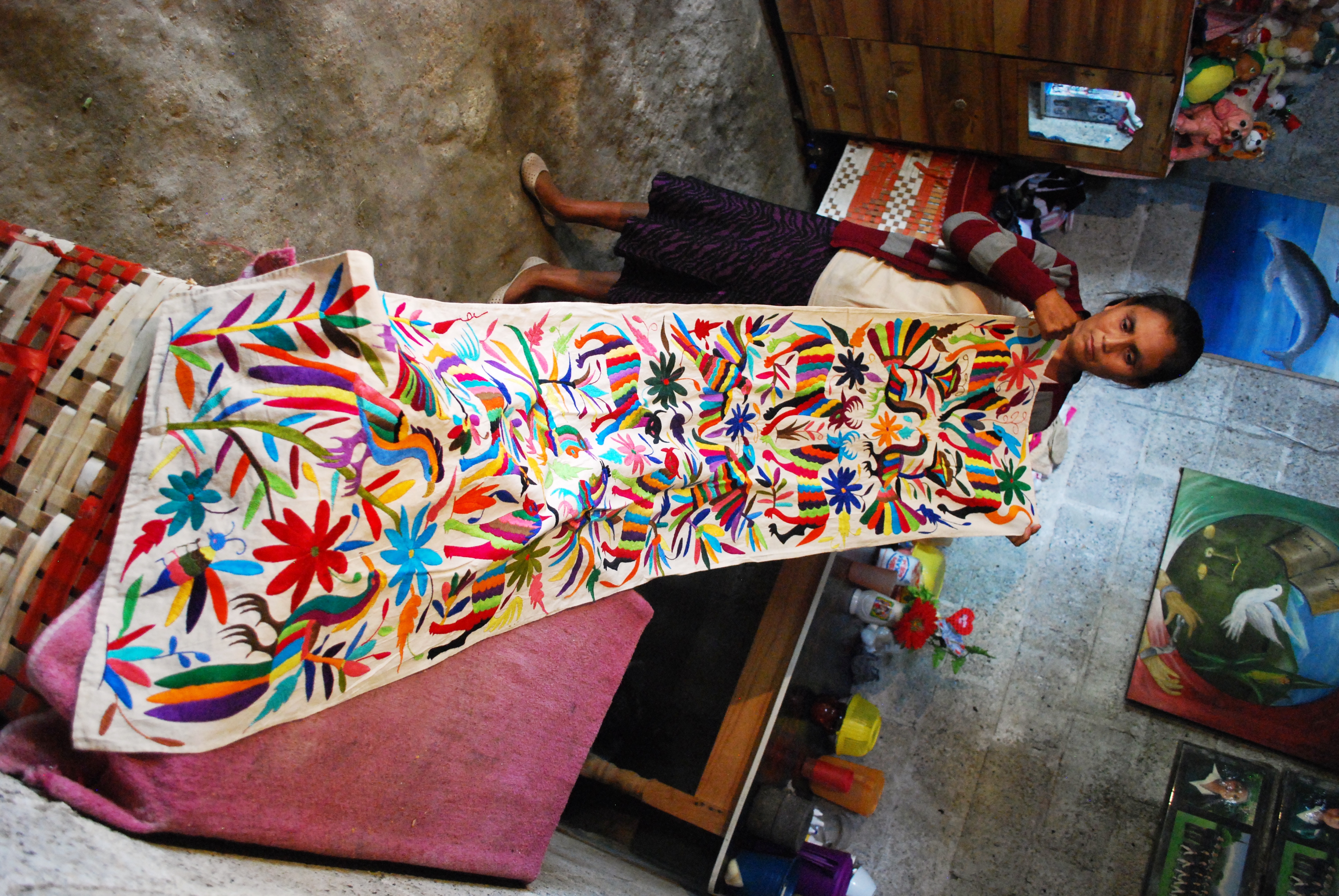Tenango Embroidery on:
[Wikipedia]
[Google]
[Amazon]
 Tenango is a style of embroidery which originated in the
Tenango is a style of embroidery which originated in the
 Modern authentic tenango embroidery is made in San Nicolas municipalities of Tenango de Doria and, to a lesser extent, neighboring San Bartolo Tutotepec. The design and manufacture is associated with the indigenous Otomi people, who call themselves . The Otomi can be found in several states in central Mexico, but the embroidery is endemic only to this area. The region is a bit different than other Otomi areas. Wedged into steep canyons, communities here located in the western
Modern authentic tenango embroidery is made in San Nicolas municipalities of Tenango de Doria and, to a lesser extent, neighboring San Bartolo Tutotepec. The design and manufacture is associated with the indigenous Otomi people, who call themselves . The Otomi can be found in several states in central Mexico, but the embroidery is endemic only to this area. The region is a bit different than other Otomi areas. Wedged into steep canyons, communities here located in the western
 The embroidery is a simplified version of embroidery done for centuries, adapted for products to be sold to the outside world. Pieces generally have multiple figurative elements in stylized form, which are arranged onto the fabric in a geometric pattern, mostly or completely symmetrical. The most common elements are the flora and fauna found in the Tenango de Doria area including chickens, dogs, wild birds, rabbits, horses, flowers and trees. Sometimes people and other objects appear as well. Other figures include figures from amate paper cut-outs made by local shamans/healers and prehistoric paintings found in local caves. These elements are most often arranged in a pattern, but can be set up for form scenes from daily life, folk festival and religion. The most common background fabric colors are white and off-white, generally for tablecloths and the like, followed by black, but other colors such as reds and blues are used as well. Most often, the elements are not done in realistic colors, rather using bright colors such as yellows, greens and blues. All elements may be of a single color, or multicolored. If the latter, the colors are most often combined as a series of stripes over the elements. Better tenangos have small, tight stitches, with a well-done tablecloth or bedspread taking up to six years to make.
The embroidery is a simplified version of embroidery done for centuries, adapted for products to be sold to the outside world. Pieces generally have multiple figurative elements in stylized form, which are arranged onto the fabric in a geometric pattern, mostly or completely symmetrical. The most common elements are the flora and fauna found in the Tenango de Doria area including chickens, dogs, wild birds, rabbits, horses, flowers and trees. Sometimes people and other objects appear as well. Other figures include figures from amate paper cut-outs made by local shamans/healers and prehistoric paintings found in local caves. These elements are most often arranged in a pattern, but can be set up for form scenes from daily life, folk festival and religion. The most common background fabric colors are white and off-white, generally for tablecloths and the like, followed by black, but other colors such as reds and blues are used as well. Most often, the elements are not done in realistic colors, rather using bright colors such as yellows, greens and blues. All elements may be of a single color, or multicolored. If the latter, the colors are most often combined as a series of stripes over the elements. Better tenangos have small, tight stitches, with a well-done tablecloth or bedspread taking up to six years to make.
 There is evidence that embroidery existed in the pre Hispanic period in Mesoamerica but it underwent radical change with the introduction of European techniques and designs. It has always been traditionally women's work, with daughters learning from mothers. Even today, most of the work is done within individual families, but there are cooperatives of women who work together to produce and promote their products.
The embroidery style now known as tenango is based on traditional Otomi embroidery of the area, but modified to create pieces to sell. This occurred in the 1960s when a regional drought severely disrupted the local economy's dependence on subsistence agriculture. The origin of this innovation has been traced to the small community of San Nicolas in the municipality of Tenango de Doria. Originally the idea was to make and sell ''pepenado'' blouses, a kind of gathered and traditional blouse still worn here. However, these are very time-consuming to make and could not be sold for a sufficient price. Instead, embroidery elements were transferred to flat pieces of fabric. Even those sold for very little, especially at the beginning when the style was unknown. Over time, the embroidery style has been applied to tablecloths, napkins, pillow cases, bedspread, various styles of clothing and more. While the work is still primarily done by women, men have taken it up, not only in Tenango but in prison handcraft programs as well.
There is evidence that embroidery existed in the pre Hispanic period in Mesoamerica but it underwent radical change with the introduction of European techniques and designs. It has always been traditionally women's work, with daughters learning from mothers. Even today, most of the work is done within individual families, but there are cooperatives of women who work together to produce and promote their products.
The embroidery style now known as tenango is based on traditional Otomi embroidery of the area, but modified to create pieces to sell. This occurred in the 1960s when a regional drought severely disrupted the local economy's dependence on subsistence agriculture. The origin of this innovation has been traced to the small community of San Nicolas in the municipality of Tenango de Doria. Originally the idea was to make and sell ''pepenado'' blouses, a kind of gathered and traditional blouse still worn here. However, these are very time-consuming to make and could not be sold for a sufficient price. Instead, embroidery elements were transferred to flat pieces of fabric. Even those sold for very little, especially at the beginning when the style was unknown. Over time, the embroidery style has been applied to tablecloths, napkins, pillow cases, bedspread, various styles of clothing and more. While the work is still primarily done by women, men have taken it up, not only in Tenango but in prison handcraft programs as well.
 The embroidery has become popular enough to be found in many sales venues in Mexico and regularly shipped abroad. Pieces can sell anywhere from 15 to 10,000 or more
The embroidery has become popular enough to be found in many sales venues in Mexico and regularly shipped abroad. Pieces can sell anywhere from 15 to 10,000 or more
 Tenango is a style of embroidery which originated in the
Tenango is a style of embroidery which originated in the Tenango de Doria
Tenango de Doria is a town and one of the 84 municipalities of Hidalgo, in central-eastern Mexico. The municipality covers an area of .
As of 2020, the municipality had a total population of 17,503. In 2017 there were 5,030 inhabitants who sp ...
municipality in the Mexican state of Hidalgo
Hidalgo may refer to:
People
* Hidalgo (nobility), members of the Spanish nobility
* Hidalgo (surname)
Places
Mexico
:''Most, if not all, named for Miguel Hidalgo y Costilla (1753–1811)''
* Hidalgo (state), in central Mexico
* Hidalgo, Coah ...
. It is a commercialized version of traditional Otomi
The Otomi (; ) are an Indigenous people of Mexico inhabiting the central Mexican Plateau (Altiplano) region.
The Otomi are an Indigenous people of the Americas who inhabit a discontinuous territory in central Mexico. They are linguistically rel ...
embroidery, which was developed in the 1960s in response to an economic crisis. It is estimated at over 1,200 artisans practice the craft in Tenango de Doria and the neighborhing municipality of San Bartolo Tutotepec
San Bartolo Tutotepec is a town and one of the 84 municipalities of Hidalgo, in central-eastern Mexico. The municipality covers an area of 305.8 km².
As of 2005, the municipality had a total population of 17,837. In 2017 there were 5,716 inh ...
.
Geographic origin
 Modern authentic tenango embroidery is made in San Nicolas municipalities of Tenango de Doria and, to a lesser extent, neighboring San Bartolo Tutotepec. The design and manufacture is associated with the indigenous Otomi people, who call themselves . The Otomi can be found in several states in central Mexico, but the embroidery is endemic only to this area. The region is a bit different than other Otomi areas. Wedged into steep canyons, communities here located in the western
Modern authentic tenango embroidery is made in San Nicolas municipalities of Tenango de Doria and, to a lesser extent, neighboring San Bartolo Tutotepec. The design and manufacture is associated with the indigenous Otomi people, who call themselves . The Otomi can be found in several states in central Mexico, but the embroidery is endemic only to this area. The region is a bit different than other Otomi areas. Wedged into steep canyons, communities here located in the western Sierra Madre Oriental
The Sierra Madre Oriental () is a mountain range in northeastern Mexico. The Sierra Madre Oriental is part of the American Cordillera, a chain of mountain ranges (cordillera) that consists of an almost continuous sequence of mountain ranges that ...
. As these mountains trap much of the moisture coming off the Gulf of Mexico, the climate here is significantly wetter with more vegetation than other Otomi areas, which has affected the development of embroidery pattern. It has also isolated the people of this area, allowing them to keep much more of the ancient traditions and worldview. In her book , researcher Carmen Lorenzo characterizes tenangos as a kind of modern-day codex, giving testimony about everyday life of the rural Otomi is this region. The world vision of these pieces are traditional as much of the ancient ideology of these communities remains intact. Many here still speak Otomi, with a portion speaking only this language. Although there is contact with the outside world via the handcraft and migration out, this has affected the development of the craft.
Description
 The embroidery is a simplified version of embroidery done for centuries, adapted for products to be sold to the outside world. Pieces generally have multiple figurative elements in stylized form, which are arranged onto the fabric in a geometric pattern, mostly or completely symmetrical. The most common elements are the flora and fauna found in the Tenango de Doria area including chickens, dogs, wild birds, rabbits, horses, flowers and trees. Sometimes people and other objects appear as well. Other figures include figures from amate paper cut-outs made by local shamans/healers and prehistoric paintings found in local caves. These elements are most often arranged in a pattern, but can be set up for form scenes from daily life, folk festival and religion. The most common background fabric colors are white and off-white, generally for tablecloths and the like, followed by black, but other colors such as reds and blues are used as well. Most often, the elements are not done in realistic colors, rather using bright colors such as yellows, greens and blues. All elements may be of a single color, or multicolored. If the latter, the colors are most often combined as a series of stripes over the elements. Better tenangos have small, tight stitches, with a well-done tablecloth or bedspread taking up to six years to make.
The embroidery is a simplified version of embroidery done for centuries, adapted for products to be sold to the outside world. Pieces generally have multiple figurative elements in stylized form, which are arranged onto the fabric in a geometric pattern, mostly or completely symmetrical. The most common elements are the flora and fauna found in the Tenango de Doria area including chickens, dogs, wild birds, rabbits, horses, flowers and trees. Sometimes people and other objects appear as well. Other figures include figures from amate paper cut-outs made by local shamans/healers and prehistoric paintings found in local caves. These elements are most often arranged in a pattern, but can be set up for form scenes from daily life, folk festival and religion. The most common background fabric colors are white and off-white, generally for tablecloths and the like, followed by black, but other colors such as reds and blues are used as well. Most often, the elements are not done in realistic colors, rather using bright colors such as yellows, greens and blues. All elements may be of a single color, or multicolored. If the latter, the colors are most often combined as a series of stripes over the elements. Better tenangos have small, tight stitches, with a well-done tablecloth or bedspread taking up to six years to make.
History
 The embroidery has become popular enough to be found in many sales venues in Mexico and regularly shipped abroad. Pieces can sell anywhere from 15 to 10,000 or more
The embroidery has become popular enough to be found in many sales venues in Mexico and regularly shipped abroad. Pieces can sell anywhere from 15 to 10,000 or more Mexican peso
The Mexican peso (Currency symbol, symbol: $; ISO 4217, currency code: MXN; also abbreviated Mex$ to distinguish it from peso, other peso-denominated currencies; referred to as the peso, Mexican peso, or colloquially varo) is the official curre ...
s depending on size and quality. They have been sold in upscale hotels and boutiques, with some artisans working with Mexican and foreign designers. For example, in 2011, French fashion label Hermes partnered with the Museo de Arte Popular and various artisans to create reproductions of the embroidery.
However, some of the marketing has been controversial. One of the main problems is that the artisans receive many times less what the piece eventually sells for. Very poor and/or non-Spanish speaking artisans may be exploited, paid as little as 100 pesos for a tablecloth or even exchanging their work for food. It is estimated there are about 1,200 artisans practicing the craft in the municipality, but the number may be much higher as it does not count children as young a five helping with the work. Despite some support from government entities like SEDESOL
The Secretariat of Welfare ( Spanish: ''Secretaría de Bienestar'') is the government department in charge of social development efforts in Mexico. The Secretary of Welfare is a member of the Executive Cabinet, and is appointed at the discretion ...
, the activity pays very little because it is very labor-intensive. Younger generations are not taking it up if they can make more money in another activity. One reason for this is that the design has no legal protection, neither copyright or trademark.
References
{{crafts of Mexico Embroidery in Mexico Hidalgo (state)